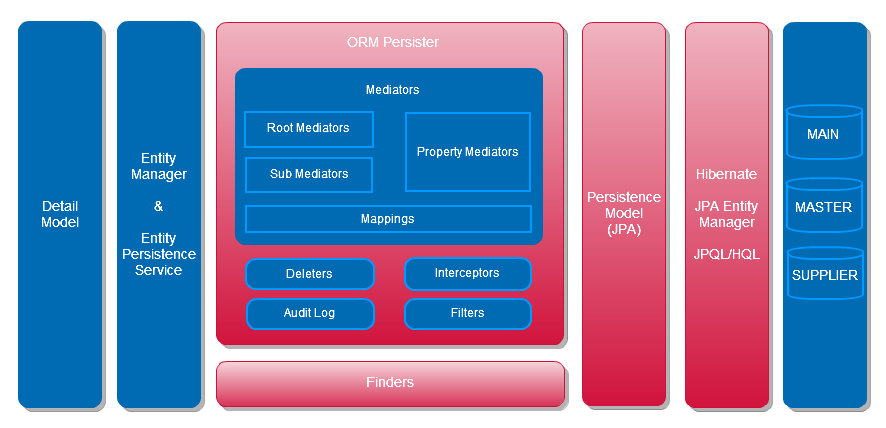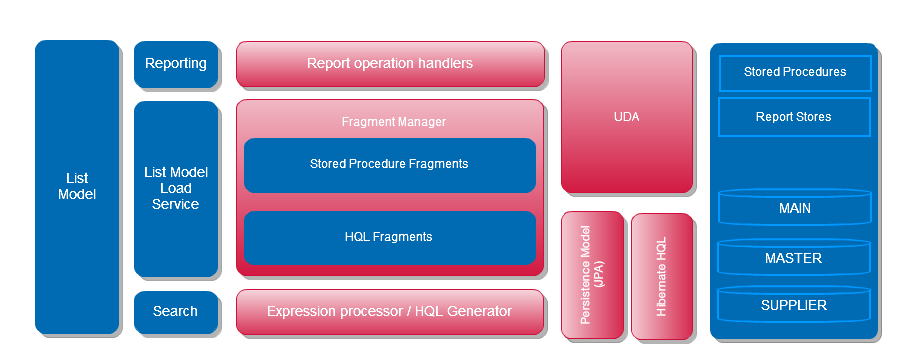Persistence
The persistence layer has different extension points which can be used to adjust the default persistence logic. Developers usually need to create extensions if the business model has been modified or extended in a non standard way. Before contributing extensions in the persistence layer, please consider other possibilities like the command framework. Keep in mind that persistence layer extensions should only used to adjust persistence logic but not to implement business logic!
Most of the persistence layer implementation logic uses meta information to perform data manipulation operations (deletion, search, update, hql queries generations etc). This meta information is composed from persistence fields defined in the repository (called mappings) and JPA persistence entities called persistence meta model. JPA entities itself are called persistence model.
Detail persistence
If you need to adjust the detail model persistence logic, the property mediators extension point is a good place to start. If you need to contribute custom data modification audit logic, please use the AuditLog extension point. Using deleters, finders and interceptors you can adjust deeper aspects of the persistence process. In rare cases you can implement custom mediators. If you create new entity types you will also need to create new persistence model entities.

List persistence
If you need to adjust list access please have a look at the Fragments extension point. If you create new EntityTypes you need to set column data in the repository and contribute respective fragment (in most cases generic HQL fragment implementation will do the work). To define new reports you will need to create PL/SQL or T-SQL stored procedures, or you can simply use search expressions.

Business and persistence models
HPM has a well defined separation between the persistence and business aspects of the domain model. Basically both models contain the same data but in the different forms and with different access methods. Business model provides generic access methods (for example using xPath-like queries), has meta information which is used for presentation, validation, business rules definition and a lot more. Business model also provides DTO capabilities like transferring disconnected data model sub-graphs over network and change logging. On the other hand persistence model is simple a set of JavaBeans enriched with JPA annotations. Persistence model is simple used to store/load data from DB using Hibernate and JPA. This approach provides a flexible and extendable model on business side and easy to implement and debug persistence technology on the other side. Data transfer between models is the task of the mediator framework. Mediators use mappings between business and persistence models which are defined in the repository.
Since the persistence model is also normalized, one could think it is exactly the same as the business model - in fact, it's not.
For example
the business model stores instances of EntityProxy, where the persistence model only stores the numeric id of the entity proxy.
customizing can introduce a 1:n field (a list) where as the persistence model just has a big string field (values will be stored by some sort of string separation).
parts of the business model might just be calculated from other fields or 3rd party systems
in business model every entity has version property, where in persistence model entity and entity revision are different objects
The central approach of the Heiler Product Manager - being easily customizable - is bound to the fact that we have a separate business model.
Mapping
As mentioned, the persistence model is quite similar to the business model. Because of this we're able to provide a lot of generic functionality which mediate between the business and the persistence model automatically - always being able to intercept and customize this of course.
For this we established a mapping model which holds the mapping information between business model and persistence model. You can obtain this model from the PersistenceComponent (PersistenceComponent.getMappingModelRegistry())
Persistence mapping in repository
The repository defines several attributes which map the business model to the persistence model
Please see the Persister Framework documentation for details on the used mapping algorithms, the following list gives only a short summary of the repository attributes.
Entity Type attributes
|
Persistence Class Name |
All entity types |
Fully qualified path to the persistence model's class which directly |
|
Persistence xPath |
All entity types |
Path to the persistence object starting from the root. |
|
Identifying Field Type |
All entity types |
The field type which uniquely identifies the record in the business as well as in the persistence model |
|
Deletion Mode |
All entity types |
Defines what deletion modes the entity supports.
|
|
Deletion Date Field Type |
All entity types |
Field type which reflects the deletion date property of the entity type. |
|
Revision Persistence Class |
Only root entity types |
Fully qualified class name of the persistence class |
|
Revision Property |
Only root entity types |
Name of the property which gives access to the set of revision objects (which based on the Revision Persistence Class) |
|
Audit Log Entity Type |
Only root entity types |
The entity type which implements the audit log functionality, |
Field Type attributes
|
Fragment Column Access |
Only used for SP based fragment access. |
|
Persistence class name |
The java data type of the physical column in the database. |
|
Persistence model class |
Fully qualified path to the persistence model's class which directly |
|
Persistence xPath |
Path to the persistence property starting from the root persistence object |
|
Physical Column Is Big |
true in case the database column is some LOB object or similar |
Persistence meta model
The meta model of the JPA provider was not able to satisfy all reqiurements which we had in order to provide the generic mapping algorithms. Therefore we created an own meta model which combines information from the JPA provider as well as the persistence classes and the annotations them self. Using this persistence model we could create generic JPQL generators for deletion of items as well as selecting data for list model access. The persistence meta model can be obtained through the DataSourceRegistry which itself is
available through the PersistenceComponent.